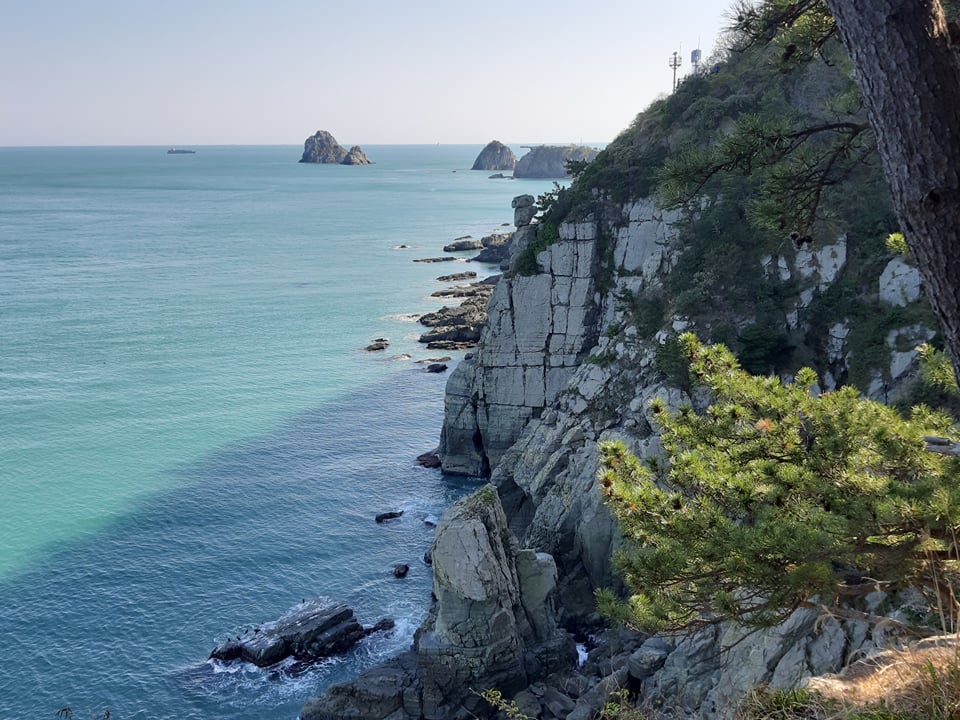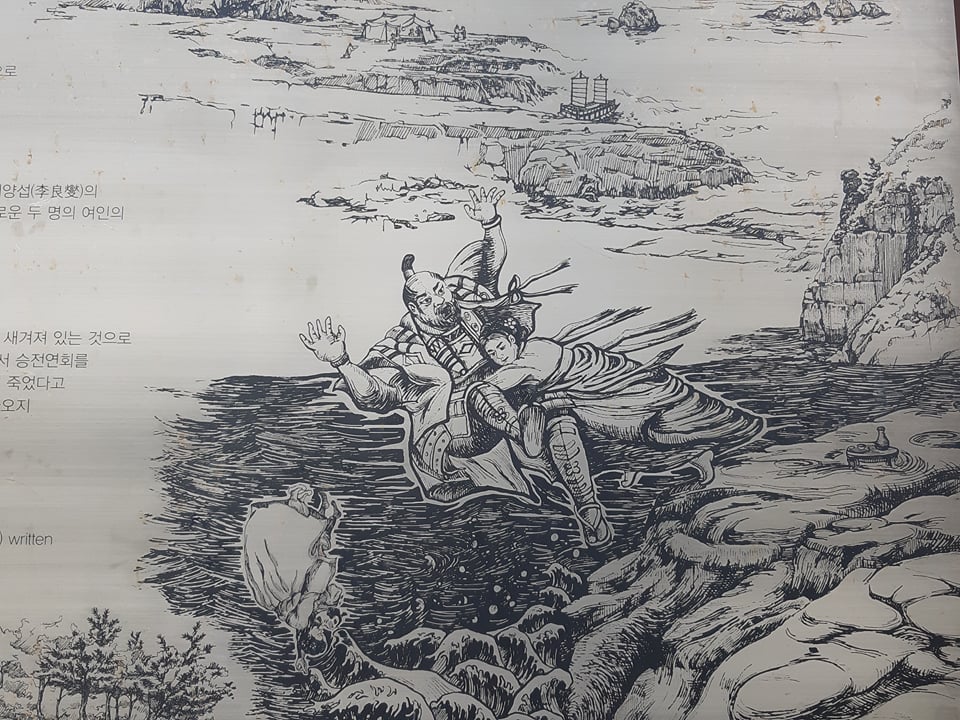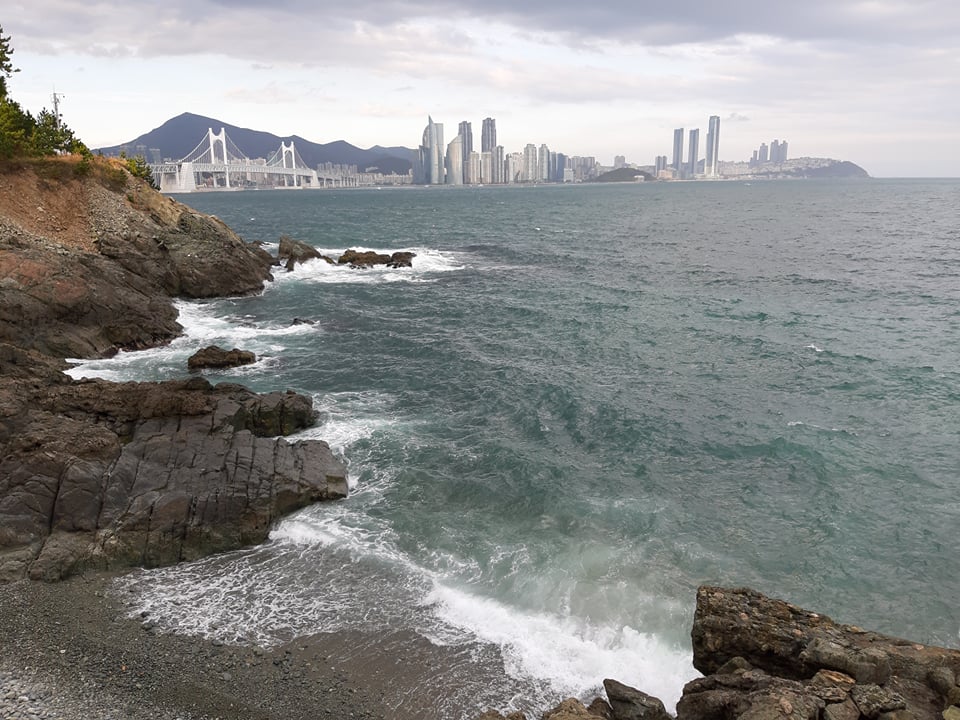The female martyrs of Igidae: Busan’s beautiful Igidae hiking trail connected to 16th century war
이기대의 여성 순교자: 부산의 아름다운 이기대 산책로 6세기 전쟁과의 연결고리

Every street was filled with corpses; Joseon was nothing but a river of blood.
거리마다 시신이 즐비했다. 조선에는 오직 피의 강만 이 흘렀다.
This was the scene following the 1593 Siege of Jinju Castle, part of a massive, unprovoked Japanese invasion of Korea begun the previous year that today is known as the Imjin War.
이것은 오늘날 임진왜란으로 잘 알려진 일본의 이유 없는 대규모 한국 침략의 일부였던 진주성 포위 이후의 장면이다. 진주성 전투는 임진왜란이 발발한 지 한 해가 지난 1593년에 일어났다.
Some sources claim 60,000 Koreans were casualties in the 19-day battle. Thousands were beheaded. Following the bloodbath, the Japanese reveled in their victory, getting drunk, brutalizing the already brutalized survivors. Samurai Invasion, an authoritative English text on the Imjin War by British historian Stephen Turnbull, describes what happened next as follows.
어떤 자료에 따르면 이 19일 간의 전투에서 6만 명의 한국인 사상자가 발생했다고 한다. 수 천 명의 사람들이 참수되었다. 대학살 끝에 일본은 그들의 승전을 축하하며 잔치를 벌였고, 이미 잔혹하게 대우받던 생존자들을 더더욱 짐승처럼 괴롭혔다. 영국 영사학자 스테티븐 턴불이 쓴 한 권위 있는 영문서는 임진왜란을 사무라이들의 침략이라고 불렀다. 이후 기술된 내용은 다음과 같다.

“That night, while the Nam River downstream from the castle walls flowed red and headless corpses still choked its banks, the victorious Japanese generals celebrated in the ChokSungnu Pavilion, from which the best view of this hellish scene could be appreciated. The gisaeng (courtesan) girls of Jinju were pressed into the service of the conquerors, and entertained them in the pavilion above the now ghastly river. That night one gisaeng struck a blow for Korea. A courtesan called Nongae became a target for the amorous affections of Keyamura Rokunosuke, a senior Japanese officer in the service of Katō Kiyomasa. Luring him close to the cliff edge, Nongae locked her arms into his passionate embrace of her, and flung herself suddenly backwards into the river, clinging on to her victim until both she and he were drowned.”
“그 밤, 진주성에서부터 흘러내리는 남강은 핏물처럼 붉었고, 목 없는 시신들이 둑을 메웠으며, 승리에 취한 일본군 장군은 그 지옥 같은 광경이 가장 잘 보이는 명당 촉석루에서 축배를 들었다. 진주의 기생들은 섬뜩한 남강 위 누각에서 침략자의 수발을 들고 그들을 기쁘게 하도록 강요 받았다. 그날 밤, 기생 중 한 명이 조국을 위해 나섰다. 가토 기요마사의 가신이었던 게야무라로 쿠스케가 논개라는 이름을 가진 이 기생에게 추파를 던졌다. 그를 절벽 끄트머리 가까이로 유혹한 논개는 그를 두 팔로 꽉 끌어안고는 뒷걸음질 쳐 강으로 몸을 던졌다. 그리고는 그와 자신의 숨이 모두 끊어질 때까지 그를 놓지 않았다.”
During those same years during which the Japanese were subjugating the southern tip of the Korean Peninsula, Nongae’s now-legendary sacrifice, widely accepted throughout South Korea as historical fact, is said to have repeated itself in Busan.
일본군이 한반도 남쪽 끝을 지배한 바로 그 기간 동안, 오늘날 역사적 사실로써 한국에 널리 받아들여진
논개의 전설적인 희생은 부산에서도 똑같이 반복되고 있었다.
Twice.
두 번이나.
Today, the site still bears their namesake: Igidae (I means two; Gee, gisaeng; and Dae, place). It is arguably the most stunning hiking trail in the country. Just enter where I usually do, at one trailhead near the W Building – the residential skyscraper near Pukyong University – and you will be immediately gobsmacked. An unbeatable panorama taking in everything from the Gwangan Bridge to the Haeundae Sound fairly explodes into view. Even if you think selfies are for squares, you can’t help but stop for a picture. On this first stretch, you’ll turn back for others, shaking your head to find the cityscape becoming still more gorgeous.
오늘날까지도 이 장소는 그들의 이름을 그대로 간직하고 있다. 바로 이기대(둘 이, 기생 기, 대 대)이다. 이기대는 한국에서 가장 멋진 등산로다. 내가 애용하는 W빌딩-부경대학교 근처의 고층 아파트- 근처의 입구에서 시작하면 곧장 놀라게 될 것이다. 광안대교부터 해운대 까지 이어지는 견줄 데 없는 파노라마가 시선을 사로잡을 테니까. 셀피는 탁 트인 곳에서 찍어야 한다고 생각한다 해도, 이곳에서는 사진을 찍지 않고는 못 배길 것이다. 첫 순간부터 당신은 일행을 향해 돌아서서는 더 욱 황홀해지는 도시 풍경에 고개를 젓게 될 것이다.
Passing this stage of the trail on a recent trip to Igidae in early April, I came abreast of a 20-something who was absolutely aglow. He was FaceTiming with someone, then spinning his phone outward to show whoever it was what we were seeing. What are you on? I wanted to ask, until I realized the spring in his step was exactly the kind that had been shot into me the first time I’d seen all this.
얼마 전인 4월 초 이기대의 이 코스를 거닐며 나는 눈부시게 빛나던 한 20대 청년을 마주쳤다. 그는 누군가와 페이스타임을 하고 있었는데, 그 상대가 누구였는지는 몰라도 휴대폰 화면을 바깥으로 향하고 그가 보고있는 광경을 상대에게 보여주었다. 뭘 하는 거지? 하고 묻고 싶었던 것도 잠깐, 내가 처음 이 광경을 보았을 때와 똑같은 봄이 그의 발걸음에 스며들어 있음을 깨달았다.
“Compared to hiking in Norway or France or Canada, it's different,” the man, who turned out to be a tourist named David Delhaye from France, told me. “What’s really nice is you have the city and the hike, so I was telling my mom just now, ‘You have the view of the city like a 400-meter tower and at the same time you’re like in the nature.’ So it’s really nice. It’s like Hong Kong – it’s even better than Hong Kong.”
“노르웨이, 프랑스, 캐나다에서 등산하는 것과는 달라요.” 데이빗 델하예(David Delhaye)라고 이름을 밝힌
프랑스인 관광객이 내게 말했다. “도심 속에서 등산을 즐길 수 있다는 게 정말 멋져요. 안 그래도 엄마와 막 통화하던 참이었어요. ‘400미터짜리 타워가 있는 도시 전망을 즐기는 동시에 자연에 있을 수 있다니까.’ 정말 마음에 들어요. 꼭 홍콩 같아요. 아니, 홍콩보다 더 좋아요.”
This side of Igidae, officially called the Dongsaengmal Trail, feels more like a climax than an exposition. The only thing that could really drive me from the scene my virgin trip was curiosity, which was what came upon me as I rounded that first corner. Wooden planking snaked for a good kilometer around the mountainside overgrown with trees and creepers so poison green that I couldn’t help but find it all a little bit sinister, like the island on Jurassic Park. Several miniature trestle bridges bring you over coves carved out of the volcanic crags that make up the coastline. If you stand staring down at the waves breaking up off these shelves long enough, you will spot an occasional fisherman as big as an ant picking his way along the treacherous rock soundlessly as the water booms around him. “How the hell did he get there?” I found myself murmuring, searching in vain for his route.
이 코스는 이기대에서 공식적으로는 동생말이라고 불리는, 클라이맥스에 가까운 곳이다. 내가 첫 이기대 여행에서 이 광경을 보고 한 걸음 더 나아갈 수 있었던 것은 첫 코너를 돌자 나를 사로잡은 호기심 덕분이었다. 나무와 덩굴이 무성한 산비탈을 따라 1km 정도 구불구불 이어진 나무 데크는 독약처럼 짙은 녹색이어서, 주라기 공원 속 섬에 온 것처럼 약간 불길한 느낌이 들었다. 몇몇 개의 작은 육교를 지나면 화산암 끝에 위치한 작은 만에 도달하게 된다. 만에 부딪혀 부서지는 파도를 충분히 감상하고 나면 물살이 휘몰아치는 위험천만한 바위 위에서 길을 찾고 있는 개미만한 크기의 낚시꾼을 종종 발견하게 될 것이다. “대체 어떻게 저기까지 간 거야?” 길을 찾으려는 노력이 헛수고로 끝난 뒤 나는 중얼거렸다.
Veer off-trail like this, as I have on several occasions at the park of late, and you can be suddenly making your way through this zany labyrinth, peering over ledges with trepidation at tidepools crashing in the chasms below. You feel, after an hour in this desolation, as if you are exploring some uncharted new world.
내가 최근에 종종 그랬던 것처럼 길에서 방향을 틀면 갑작스러운 미궁 속으로 발을 들여놓게 된다. 파도가
무시무시한 소리를 내며 부서지는 바위 틈을 내려다보면서 말이다. 한 시간 정도 이 적막감을 즐긴 후에는 마치 새로운 미지의 세계를 탐험한 듯한 기분이 든다.

All of this is a solution to the age-old complaint foreigners commonly lodge about Korea: it’s too crowded. A friend of mine from South Africa once commented to me, “You can try as hard as you want in Korea – you will never be alone. You could be sitting 10 miles into the mountains and you will still turn around and find a Korean ahjussi sitting behind you smoking a cigarette.”
이 모든 것은 외국인들이 한국에 대해 오랫동안 불평해 온 문제에 대한 해결책이다. 바로 사람이 너무 많다는 것이다. 남아프리카에서 온 친구 한 명은 내게 이렇게 말했다. “한국에서는 원하는 만큼 노력할 수 있어. 결코 혼자가 아닐 테니까. 10마일 깊이의 산속에 앉아 있더라도 주변을 돌아보면 바로 네 뒤에서 담배를 피고있는 한국인 아저씨를 만날 수 있지.”
Molly and Luke, a pleasant young couple visiting from the U.K. that I met on my last trip to Igidae, likewise told me that while they liked the trail, they found it “quite busy.” It’s a statement that would never come out of the mouths of people who actually live in the country, though. We know that a place like Igidae – especially the hushed, sometimes arduous middle section of the trail which the tourists just in it for a few Instagram shots never make it to – is pretty much the least crowded place you can hope to find, especially in a metropolis like Busan.
영국에서 왔다는 유쾌한 젊은 커플인 몰리와 루크는 제일 최근의 이기대 나들이에서 만난 친구들이다. 그들역시 내게 산책로가 무척 마음에 드는 반면 “상당히 붐빈다.”고 말했다. 하지만 이것은 실제로 한국에 사는 사람들의 입에서는 결코 나오지 않을 말이다. 우리는 이기대와 같은 장소-특히 인스타그램에 남길 사진 몇 장을 찍기 위해 온 관광객들은 결코 오지 않는, 고요하고 때로는 고되기까지 한 중간 지점-은 당신이 원하는 가장 덜 붐비는 장소가 될 수 있다. 특히나 부산처럼 큰 광역시에서는 더욱이.
Sung Woo An, a 60-year-old man I met hiking with his wife, agreed.
등산 도중 마주친 60세의 안성우 씨와 그의 아내도 동의했다.
“Igidae is kind of a secret course in Busan,” said An, who hikes the trail once every one or two months. “But for serious hikers, it’s definitely a must-do trail.”
“이기대는 부산의 숨겨진 코스라고 할 수 있죠. 하지만 진지한 등산객이라면 꼭 한 번 와 봐야 하는 곳입니다.” 한두 달에 한 번은 반드시 이기대를 찾는다는 안성우 씨가 말했다.
That Igidae remains a “secret” destination seems all the more surprising given the story associated with it. Go to Igidae – especially the final portion, which features an escarpment that continues right on to Oryukdo – and at first glance, the story seems exceedingly plausible. There are ample cliffs, the kind that climb to the sky and make you weak at the knees, where two vengeful gisaeng almost certainly could have lured drunk, lust-crazed Japanese generals and executed Nongae-style assassinations. If it’s true, one would expect these women to be among the most famous in Busan’s history.
이기대가 “숨겨진” 장소로 남아있다는 것은 관련 설화를 고려해보면 오히려 놀라운 일이다. 이기대로 가보자-특히나 오륙도로 바로 이어지는 급경사면이 있는 마지막 구간- 그러면 첫 눈에 그 설화가 정말로 그럴듯하다는 사실을 알게 될 것이다. 하늘을 향해 오르다 보면 무릎이 꺾일 정도로 거대한 절벽은 복수심에 불타는 두 명의 기생이 술에 취해 욕망에 찬 일본 장군들을 유혹해 논개처럼 암살했을 거라는 사실이 거의 분명해 보인다. 만약 이 설화가 진실이라면 혹자는 이 기생들이 부산의 역사적 인물 중 가장 유명한 인물 중 하나가 될 것이라고 기대할 수도 있겠다.
But that’s the caveat: even though the Japanese did sack Busan just as they did Jinju at the start of the Imjin War, the veracity of Busan’s gisaeng story isn’t accepted like that of Jinju’s Nongae.
하지만 여기에는 주의할 점이 있다. 실제로 일본군이 임진왜란 초기 진주성에서 그랬던 것처럼 부산을 약탈했다 하더라도, 부산 기생의 이야기는 진주의 논개 이야기처럼 진실로 받아들여지지는 않는다.
Save for two identical tombs near Igidae mentioned cryptically in a book called Chronicles of Dongnae Military Base, no published accounts of this story exist, according to Changseob Lee, a researcher in the Department of Cultural Heritage in Busan. For years after the Imjin War, the story was likely spread from person to person, but because there are no historical records backing up the story of Busan’s gisaeng martyrs, he said it will always be impossible to prove.
부산 문화유산과 이창섭 연구원의 말에 따르면, 동래군영 연대기라는 책에서 비밀스럽게 언급한 이기대 근처의 쌍둥이 무덤을 제외하고는 이들에 대한 이야기가 기록된 다른 출판 기록은 존재하지 않는다고 한다. 임진왜란 이후 몇 년 간 이 설화는 구전되었을 수 있지만, 부산의 기생 순교자들에 대한 이야기를 뒷받침해줄 역사적 근거가 없으므로, 이창섭 연구원은 아마 앞으로도 증명이 힘들 것이라고 말했다.
“It is possible that the people who lived here at the time heard Nongae's story and created the loyalty of the two gisaeng of Igidae. Of course, this is only my opinion and judgment,” Lee said. “But the fact that the story has been told for a long time shows Koreans' spirit of selfless resistance to foreign invasions. We have always had this perception of ourselves as a people, and this idea lives on.”
“당시 이곳에 살았던 사람이 논개의 이야기를 듣고 이기대 두 기생의 충절에 관한 설화를 만들어냈을 수도 있습니다. 물론 이것은 제 개인적인 의견과 판단이죠. 하지만 이 이야기가 오랫동안 전해져 내려왔다는 것은 외세의 침략에 대한 한국인들의 이타적인 저항 정신을 보여줍니다. 우리는 한 민족으로서 언제나 이런 가치관을 가지고 있었고, 이 정신이 지금까지도 남아있는 겁니다.”

